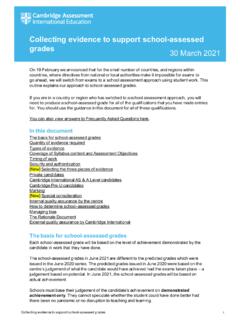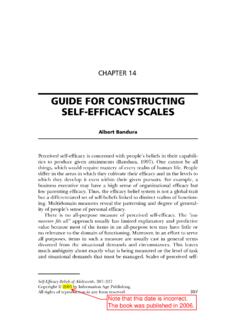Transcription of Gender Equality in the Labor Market in the Philippines
1 Gender Equality . IN THE Labor Market . in the Philippines Gender Equality in the Labor Market in the Philippines 2013 Asian Development Bank All rights reserved. Published in 2013. Printed in the Philippines . ISBN 978-92-9254-403-4 (Print), 978-92-9254-404-1. PSN RPT136187-3. Cataloging-in-Publication Data Asian Development Bank. Gender Equality in the Labor Market in the Philippines . Mandaluyong City, Philippines : Asian Development Bank, 2013. 1. Gender Equality 2. Labor Market I. Asian Development Bank. The views expressed in this publication are those of the authors and do not necessarily reflect the views and policies of the Asian Development Bank (ADB) or its Board of Governors or the governments they represent. ADB does not guarantee the accuracy of the data included in this publication and accepts no responsibility for any consequence of their use. By making any designation of or reference to a particular territory or geographic area, or by using the term country . in this document, ADB does not intend to make any judgments as to the legal or other status of any territory or area.
2 ADB encourages printing or copying information exclusively for personal and noncommercial use with proper acknowledgment of ADB. Users are restricted from reselling, redistributing, or creating derivative works for commercial purposes without the express, written consent of ADB. Note: In this publication, $ refers to US dollars. All cover photos are from AFP Image Forum and Shutterstock. 6 ADB Avenue, Mandaluyong City 1550 Metro Manila, Philippines Tel +63 2 632 4444. Fax +63 2 636 2444. For orders, please contact: Public Information Center Fax +63 2 636 2584. Contents List of Tables, Figures, and Boxes v Abbreviations vi Foreword vii Acknowledgments viii Executive Summary ix I. Introduction 1. Major Themes and Challenges 1. Structure of the Report 2. II. Gendered Employment and Inclusive Growth 3. Review of Key Terms 3. Decent Work and Development in the Philippines 6. Employment Performance 7. Gender Gaps in the Labor Market 9. Labor Force Participation Gaps 10. Unpaid Domestic and Care Work Gap 11.
3 Human Capital Gap 12. Gender Gaps in Labor Market Outcomes 13. Employment Gap 13. Decent Work Gap 15. Social Protection Gap 16. Gendered Analysis of Labor Markets: Industrial Sectors 17. Agriculture, Forestry, and Fishing 18. Industry 20. Services 21. Entrepreneurship 23. International Migration 23. Pathways to Gender Equality in the Labor Market and Inclusive Growth 24. III. Review of Policies for Gender Equality in the Labor Market 25. National Development Goals and Macroeconomic Policies 25. High-Level Goals and Commitments to Gender Equality 25. Monetary Policy 26. Fiscal Policy 26. Trade Policy 27. Employment Policy 27. National Women's Ministries or Commissions and Gender Equality Strategies 28. Key Sector Policies 30. Agriculture 30. Industry and Manufacturing 34. Tourism 36. iii Contents Business Process Outsourcing 37. Government Services 38. Entrepreneurship 38. Labor Support Policies 40. Social Protection 40. Training, Skills Development, and Transition to the Labor Market 42.
4 IV.. Review of Legislative Frameworks and Laws for Gender Equality in the Labor Market 46. Legislative Framework 46. Promoting Women's Access to Work 47. Employment and Recruitment Services 48. Short-Term Contracts 48. Limiting Constraints on Work 49. Family Responsibilities 49. Lack of Access to Property 51. Improving Women's Working Conditions 51. Equal Pay and Minimum Wages 52. Complaint Mechanisms 53. Labor Inspectorate 53. Social Dialogue and Trade Unions 55. V.. Policy and Legislative Recommendations for a Gender -Inclusive Labor Market 56. Promoting Access to Work and Enhancing Employment Opportunities for Women 56. National Plans and Policies 56. Agriculture 57. Industry and Manufacturing 58. Services Sector 58. Entrepreneurship for Rural Women 59. Public and Private Employment Agencies 60. Limiting Constraints on Work for Women 60. Access to Resources 60. Reducing Women's Domestic Work and Care Burden 61. Improving Women's Working Conditions 61. Social Protection in the Informal Sector 61.
5 Training Programs and Skills Development 61. Legislation and Decent Work Requirements 61. Antidiscrimination Legislation 61. Legislation on Multiple Short-Term Contracts 61. Decent Work Measures 62. References 64. iv Tables, Figures, and Boxes Tables 1 Development and Population Indicators in the Philippines 7. 2 Most Recent Employment Indicators in the Philippines 9. 3 Education Indicators in the Philippines , 2000 and 2010 12. 4 Employment Indicators, Women and Men in the Philippines , Selected Years 13. 5 Average Wage and Gender Wage Gap in the Philippines , 2011 16. 6 Distribution of Employment by Industry, Women and Men in the Philippines , 2011 18. Figures 1 Labor Force Participation Rates, Women and Men in Cambodia, the Philippines , and Kazakhstan, 2001 and 2012 10. 2 Women's Labor Force Participation Rates by Age in the Philippines , 2000 and 2010 11. 3 Men's Labor Force Participation Rates by Age in the Philippines , 2000 and 2010 11. 4 Share of Vulnerable Employment, Women and Men in Cambodia, the Philippines , and Kazakhstan, Selected Years 14.
6 5 Vulnerable Work Gender Gap in Cambodia, the Philippines , and Kazakhstan, 2000, 2004, and 2012 14. 6 Employment Share by Economic Sector, Women and Men in the Philippines , 2001 and 2011 17. 7 Distribution of Women's Employment by Occupation in the Philippines , 2011 19. 8 Distribution of Men's Employment by Occupation in the Philippines , 2011 20. Boxes 1 Women's Employment in the Business Process Outsourcing Sector, Philippines 21. 2 Gender -Responsive Economic Actions for the Transformation of Women Project, Philippines 29. 3 Gender Budgets, Philippines 30. 4 Women Working in Rice and Vegetable Production, Philippines 32. 5 Negros Women for Tomorrow Foundation, Philippines 33. 6 MyFirstJob, Philippines 43. v Abbreviations ADB Asian Development Bank ASEAN Association of Southeast Asian Nations BPO business process outsourcing CEDAW Convention on the Elimination of All Forms of Discrimination against Women DOLE Department of Labor and Employment ECCD early childhood care and development FAO Food and Agriculture Organization of the United Nations GDP gross domestic product GREAT Gender -Responsive Economic Actions for the Transformation of Women ILO International Labour Organization LFPR Labor force participation rate MDG Millennium Development Goal MSMEs micro, small.
7 And medium-sized enterprises NGO nongovernment organization PCW Philippine Commission on Women PDP Philippine Development Plan PESO public employment service office PLEP Philippine Labor and Employment Plan SMEs small and medium-sized enterprises TESDA Technical Education and Skills Development Authority TVET technical and vocational education and training UNDP United Nations Development Programme WRTS wholesale and retail trade and services International Labour Organization Conventions C2 Unemployment Convention C81 Labour Inspection Convention C84 Right of Association C87 Freedom of Association and Protection of the Right to Organise Convention C88 Employment Service Convention C94 Labour Clauses (Public Contracts) Convention C96 Convention Concerning Fee-Charging Employment Agencies (revised). C98 Right to Organise and Collective Bargaining Convention C100 Equal Remuneration Convention C111 Discrimination (Employment and Occupation). C129 Labour Inspection (Agriculture). C144 Tripartite Consultation (International Labour Standards) Convention C154 Collective Bargaining Convention C156 Workers with Family Responsibilities Convention C181 Private Employment Agencies Convention vi Foreword I.
8 Ncreasing job opportunities and decent work for women are essential for inclusive growth, and they are vital for advancing economic and social development in a country. This approach to attaining economic and social wealth is based on reliable academic and statistical evidence and is increasingly accepted by international and national financial and development organizations across the globe, including in Asia. However, attitudes toward providing decent work to men and women alike, irrespective of their ethnic origin and class, continue to be ambiguous, complex, and controversial, because the issue touches on deeply felt societal values in interpersonal relations, culture, religion, economics, and politics. In Asia, as in other parts of the world, it is mostly women who continue to experience the greatest disadvantages resulting from Gender inequalities and entrenched discrimination in work and in life. The economic and social contributions made by women in the family, the workplace, and society tend to be devalued.
9 There are, however, many strategies which have been developed to counter Gender discrimination and promote Equality for working men and women through legislation and social and economic policies to reverse the unequal Labor Market outcomes for women. In order to document the nature and extent of Gender inequalities in the Labor Market , as well as to capture and share these promising initiatives, the Asian Development Bank (ADB). initiated studies in three countries Cambodia, Kazakhstan, and the Philippines to identify how these countries promote Gender Equality in their Labor markets. In addition, in view of the interest in sharing good practices in developing member countries, ADB, in cooperation with the International Labour Office in Bangkok, supported the production of two global good practice reports one on legislation and legal practices and the other on economic and social policy practices as well as updates for Cambodia and the Philippines . This report on Gender Equality in the Labor Market in the Philippines was undertaken with the support of the Philippine Commission on Women.
10 The product of this combined project is five reports. The two global reports, authored by Robyn Layton and Fiona MacPhail, illustrate how the combination of good practices in law and social and economic policies working together can improve equitable employment opportunities, remuneration, and treatment for women and men at work. It is important for social justice and is also smart economics. Another report, also authored by Robyn Layton and Fiona MacPhail, analyzes and makes recommendations for Gender Equality in the Labor Market in Cambodia, Kazakhstan, and the Philippines . The series concludes with two reports on Gender Equality in the Labor Market , focused on the situation in Cambodia and the Philippines , to support the development of decent work and Gender Equality good practices in these countries. Bindu N. Lohani Yoshiteru Uramoto Vice-President for Knowledge Management Assistant Director General and and Sustainable Development Regional Director Regional and Sustainable Development Department Asia and the Pacific Region Asian Development Bank International Labour Organization vii Acknowledgments W.
















